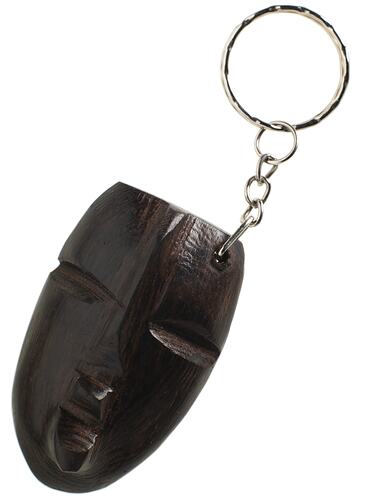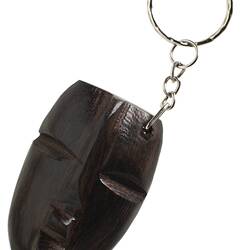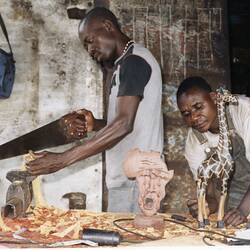Summary
Key ring made from ebony by Nickel Mundabi Ngadwa in his workshop in Douala, Cameroon, 2006-2009. In Douala, Nickel created and managed a workshop which trained underprivileged young people in painting, sculpting and furniture making. The workshop produced a number of small items such as key rings, jewellery, jewellery and animal statues.
Nickel was born in 1965 in the Democratic Republic of Congo and was a teacher and artist when he was forced to flee in 2000 and seek refuge in Cameroon with his family. They arrived in Australia as refugees in 2009 and settled in Shepparton in northern Victoria. Nickel continues as a practising artist, while also working separate jobs and producing items like this key ring for sale to support his family. He has exhibited his sculpture and paintings in a number of exhibitions. His artwork reflects both his traditional culture and the artistic influences of his grandfather, as well as more contemporary and abstract forms.
Physical Description
Dark timber carved mask with the key ring attache to the top left hand corner of the mask. This timber is a little lighter/ more brown than the other two mask key rings. The shape is also rounder. There is a ridge down the centre of the mask ending in a mouth. The eyes on either side of this ridge are carved horizontal lines.
Significance
This collection represents a body of work by Shepparton-based, Congolese artist Nickel Mundabi Ngadwa who arrived in Australia via the Refugee and Humanitarian Program in 2009. The selection includes items made by Nickel in Kinshasa, Democratic Republic of Congo where he grew up, was educated and taught art; Douala, Cameroon where he created and maintained an artist's workshop and also in Shepparton where he is re-establishing himself as an artist. Nickel's inspiration originated from his grandfather who was also an artist. Two masks created by his grandfather are also included in this selection to demonstrate the continuation of traditional mask making and also the transfer of artistic inspiration and skill between generations. The objects and accompanying narrative provide an insight into the experiences of an urban based refugee in Africa as well as the experiences of a recently arrived refugee, regional settlement in Victoria, the challenges of adapting to a new society and artistic practice translated into a new environment.
More Information
-
Collecting Areas
-
Acquisition Information
Purchase from Mr Nickel Mundabi Ngadwa, Gertrude N. Lenda, 10 Apr 2013
-
Artist
Mr Nickel Mundabi Ngadwa, Douala, Cameroun (Cameroon), 2006-2009
-
Classification
Cultural identity, Ethnicity - creative practice, Woodworking
-
Category
-
Discipline
-
Type of item
-
Overall Dimensions
57 mm (Width), 35 mm (Depth), 15 mm (Height)
-
Keywords





